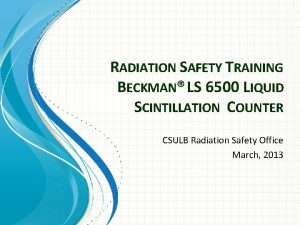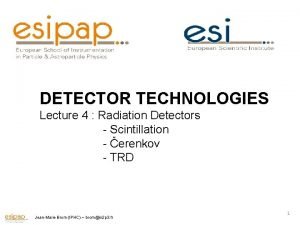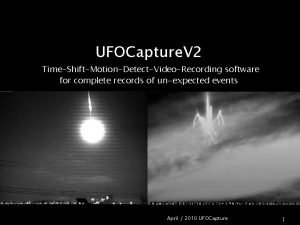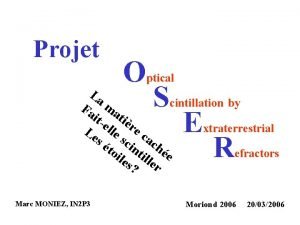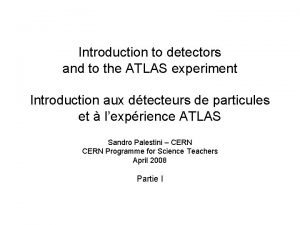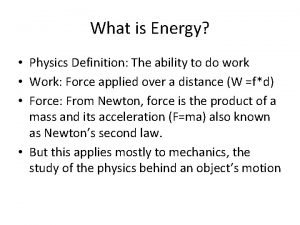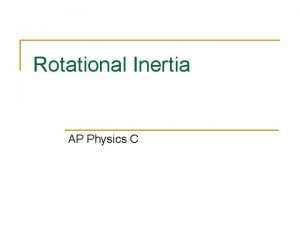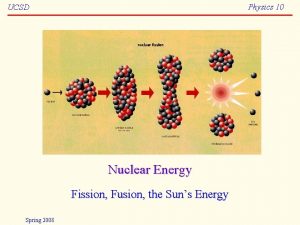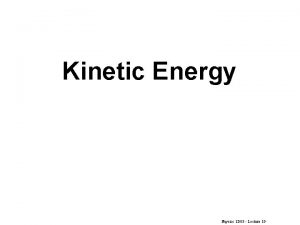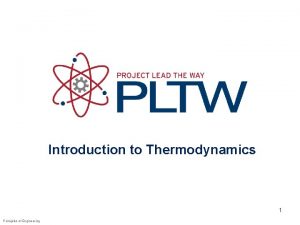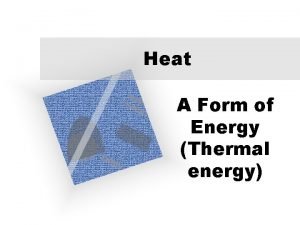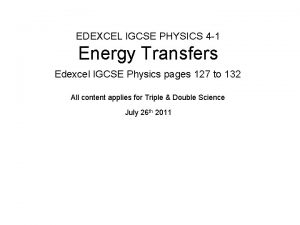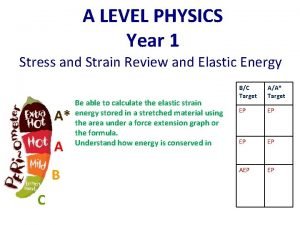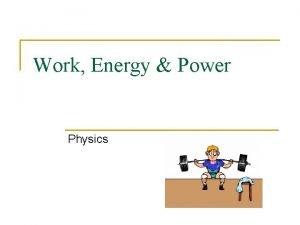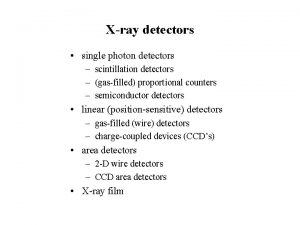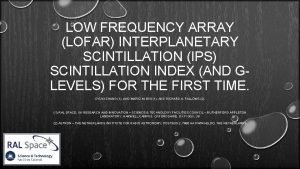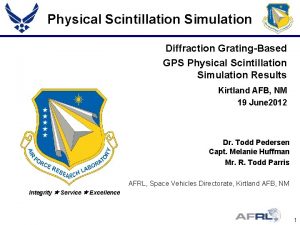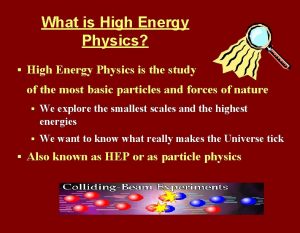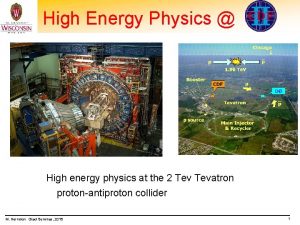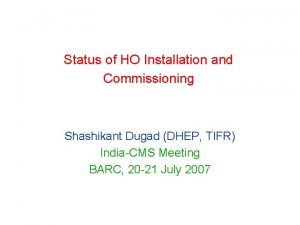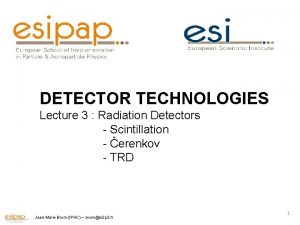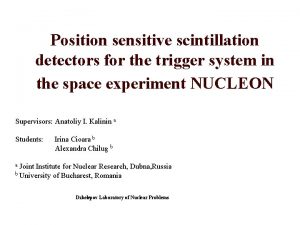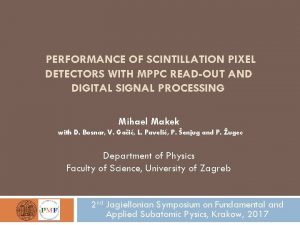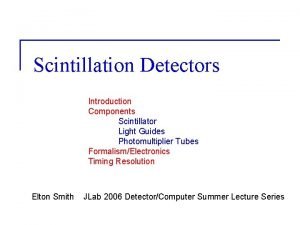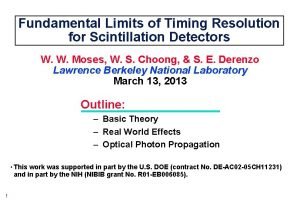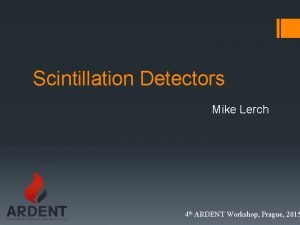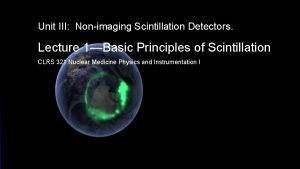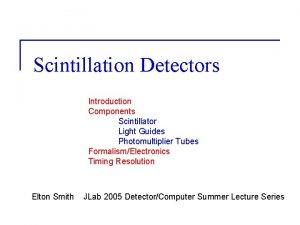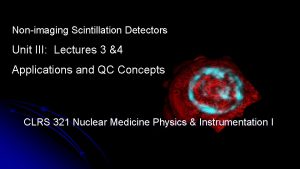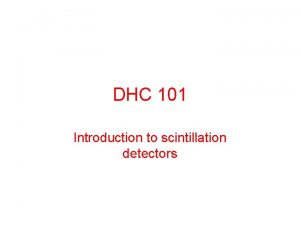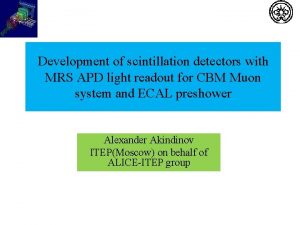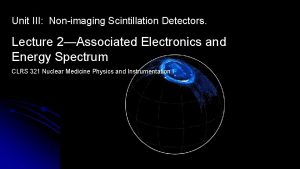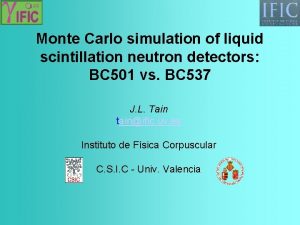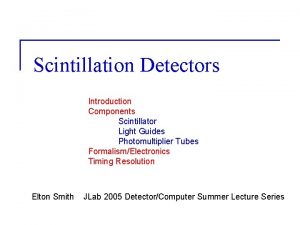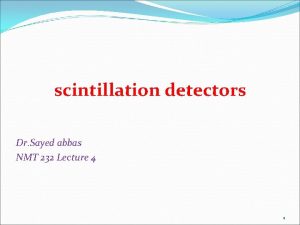Scintillation Detectors in High Energy Physics Shashikant R






































- Slides: 38

Scintillation Detectors in High Energy Physics Shashikant R. Dugad Tata Institute of Fundamental Research Ref. Summer Student Lecture Series 2001, by C. Joram at CERN

Scintillators • Fast Light Emitting Medium on passage of charged particle – Inorganic Scintillators (Slow Response, high light o/p) – Organics Scintillators (Fast Response, low light o/p) Analog Signal

Inorganic Scintillators Temp. dependent light o/p Inorganic Scintillators are costly and mostly used in Nuclear Physics Experiments Response time varies from ~10 -1000 nsec Pb. WO 4 is used to make calorimeter to measure energy of e+e- γ

Organic Scintillators Monocrystals: napthalene, anthracene, p-terephenyle Liquid and plastic scintillators: Composed of solvent + dopent (popup) used as wavelength shifter (from UV to visible) Organic scintillators are cheap and have fast response (~ few nsec) Made and used in Ooty-GRAPES 3 experiment

Properties of Organic Scintillators Used in large area detection requirement: Sampling EM component in air showers, Hadron Calorimeter, Muon time tagging in accelerator experiment

Scintillation Light Transport Scintillation light comes out from all surfaces …. . Needs to be navigated to photodetector GRAPES 3 Scintillator

Light transport in fibers

Scintillating fiber tracker UA 2 experiment

Detection of scintillation photon (photo detector) n tio la til in Sc n to o ph on P t ho oe tr lec Photo sensitive material (photocathod) Epe = Eγ - W


Quantum Efficiency of Photo cathode

Estimation of Signal Strength Charged particle passes through 1 cm thick scintillator Total Energy loss by ionisation ~ 2 Me. V Number of scintillation photons produced ~ 20000 (λ~200 -600 nm) Number of photons captured by WLS fiber ~ 200 Number of photo electrons produced at photo cathode ~ 20 Total number of electrons at PMT last dynode (i/p of preamp) ~ 10 8

PMT Signal Resolution GRAPES 3 PMT

Photo Detectors

Hybrid Photo Diode HPDs are used in CMS experiment for HCAL detector

Si-Photo Multiplier

Applications μ Scintillator Tracker (Gas Detector) p p Tracker (Gas Detector) Scintillator Muon Bunch Crossing Tagging in D 0 experiment

Si. PM Response to Muons Si. PM Make a) b) c) d) CPTA 1 CPTA 2 IRST(FBK) Hamamatsu Si. PM Size (mm) 2. 1 2. 8 3. 0 x 2. 1 dia x 3. 0 Pixel Size (μ) 50 50 # of pixels 1800 2400 3600 Shashi Dugad, WAPP, Ooty, 18 Dec 2012 18

Silicon Photomultiplier • Characterization – I-V characteristics – Single pixel calibration – Linearity, MIP sensitivity – Micron resolution optical scanner for studying pixel-to-pixel response Shashi Dugad, WAPP, Ooty, 18 Dec 2012 19

IV Characteristic of Si. PM Shashi Dugad, WAPP, Ooty, 18 Dec 2012 20

LED Calibration Setup Signal Generator LED Si. PM Trigger q. ADC Signal VME Crate Data Shashi Dugad, WAPP, Ooty, 18 Dec 2012 Computer 21

Noise Rate and LED Response Shashi Dugad, WAPP, Ooty, 18 Dec 2012 22

LED Test Results for Pixel 01 Shashi Dugad, WAPP, Ooty, 18 Dec 2012 23

MIPs with Si. PM at Ooty WLS Fibers laid on scintillator (25 x 25 cm 2) terminated onto Hamamatsu Si. PM MIP signal with 44 p. e. at peak is seen (high Q. E. ) Shashi Dugad, WAPP, Ooty, 18 Dec 2012 24

Temperature Dependence of the Gain Cosmic muon data taken over period of 2 days Temp. variation of 4 OC Data binned in temp. slice of 0. 25 OC MIP peak obtained for each set plotted as function of temp. Shashi Dugad, WAPP, Ooty, 18 Dec 2012 25

CMS Detector HF HO HB HE Shashi Dugad, WAPP, Ooty, 18 Dec 2012 26

TB 2009: HB Setup Shashi Dugad, WAPP, Ooty, 18 Dec 2012 27

Application of Si. PM in CMS Detector Fibers from Scintillator tiles Shashi Dugad, WAPP, Ooty, 18 Dec 2012 28

HPD and Si. PM Response Muons with HPD 50 Ge. V Discharge in HPD Si. PM in Magnetic Field S/B~2 Muons with Si. PM S/B~15 Shashi Dugad, WAPP, Ooty, 18 Dec 2012 29

Si. PM Control Board 160 boards fabricated indigenously by GRAPES 3, Ooty Shashi Dugad, WAPP, Ooty, 18 Dec 2012 30

Data Set Muon Beam at 150 Ge. V Pion-Beam Energy Beam Directio n(η, φ) 7, 3 300 Ge. V 7, 4 225 Ge. V 150 Ge. V 100 Ge. V 50 Ge. V 300 Ge. V 150 Ge. V 100 Ge. V 50 Ge. V 30 Ge. V 8, 3 300 Ge. V 150 Ge. V 100 Ge. V 50 Ge. V 30 Ge. V 8, 4 300 Ge. V 150 Ge. V 100 Ge. V 50 Ge. V 30 Ge. V 150 K events (ped+pion) events at each energy and position Shashi Dugad, WAPP, Ooty, 18 Dec 2012 31

HO Calibration with 150 Ge. V Muons Shashi Dugad, WAPP, Ooty, 18 Dec 2012 32

Analysis procedure …contd • Subtract pedestal from signal and normalise by with muon calibration constant – Number of MIPS n. MIPs • • Take n. MIPs(i) sum for all 9 towers at each depth of HB and HO • • Natural Relative Weights: • Pion Energy = Constant*[A*n. MIPs(1) + B*n. MIPs(2) + C*n. MIPs(3) + D*n. MIPs(4) + E*n. MIPs. HO] A=0 B=C=1 D=6 E ~ 3. 1 Estimation of Weights – Pion data at 300 Ge. V at eta=7 and phi=3 used to estimate weights for each depth of HB and one layer of HO – Vary one of the weights by fixing other weights to natural values and obtain RMS/Mean as function of that weight EGe. V=0. 247*(1. 05*n. MIPs(2) + 1. 0*n. MIPs(3) + 6. 2*n. MIPs(4) + 3. 2*n. MIPs. HO) Shashi Dugad, WAPP, Ooty, 18 Dec 2012 33

Zecotek response to 300 Ge. V Pions in HO at Eta=7 Phi=4 Shashi Dugad, WAPP, Ooty, 18 Dec 2012 34

Zecotek/Hamamatsu response to 300 Ge. V Pions in HO at Eta=7 Shashi Dugad, WAPP, Ooty, 18 Dec 2012 35

Relative Weight Factor for HB/HO Shashi Dugad, WAPP, Ooty, 18 Dec 2012 36

Resolution of HB+HO O Shashi Dugad, WAPP, Ooty, 18 Dec 2012 37

Summary • Si. PM is photo-readout element of 21 st century • Being used in large high energy physics experiments • GRAPES-3 collaboration have completed HOupgrade (~2800 channels) for CMS experiment • Potential candidate in medical industry for imaging • Several groups within country are working on this device Shashi Dugad, WAPP, Ooty, 18 Dec 2012 38
 Frontier detectors for frontier physics
Frontier detectors for frontier physics Dr shashikant shetty
Dr shashikant shetty Beckman ls6500 liquid scintillation counter
Beckman ls6500 liquid scintillation counter Hpdcms
Hpdcms Scintillation
Scintillation Cintillate
Cintillate Scintillation
Scintillation Scintillation liquide
Scintillation liquide Scintillation
Scintillation Where are feature detectors located
Where are feature detectors located Feature detectors ap psychology
Feature detectors ap psychology Rhmd: evasion-resilient hardware malware detectors
Rhmd: evasion-resilient hardware malware detectors Feature detectors
Feature detectors Yodsawalai chodpathumwan
Yodsawalai chodpathumwan Photo detectors
Photo detectors Streaming current
Streaming current Vhv voltage detectors
Vhv voltage detectors Photo detectors
Photo detectors Nuclear detectors
Nuclear detectors Hplc detector types
Hplc detector types Giant wave detectors murmurs universe
Giant wave detectors murmurs universe Giant gravitational wave detectors hear murmurs
Giant gravitational wave detectors hear murmurs Energy energy transfer and general energy analysis
Energy energy transfer and general energy analysis Energy energy transfer and general energy analysis
Energy energy transfer and general energy analysis Why does it happen
Why does it happen University physics with modern physics fifteenth edition
University physics with modern physics fifteenth edition Ia topics for physics
Ia topics for physics Power formula
Power formula What is work physics
What is work physics Energy energy
Energy energy Kinetic angular energy
Kinetic angular energy 0kei0
0kei0 Nuclear fission
Nuclear fission Energy physics definition
Energy physics definition Thermal energy formula
Thermal energy formula Energy thermal formula
Energy thermal formula Energy flow diagram physics
Energy flow diagram physics Strain energy formula
Strain energy formula Work energy theorem formula
Work energy theorem formula


